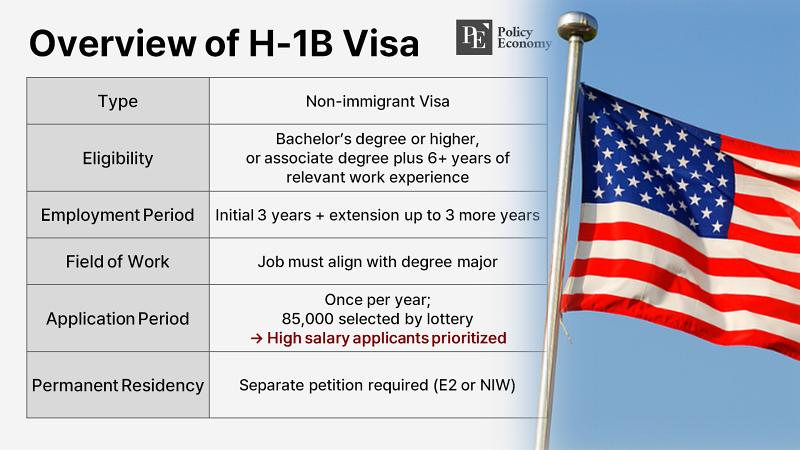America's Immigration Gate Is Closing Again — Where Will the Brain Drain Go Now?
Input
Modified
"Hiring Foreign Workers Reduces Jobs" Gains Traction
Universities Alarmed by Potential OPT Elimination
Canada’s Role as a Refuge Also Reaching Its Limits
The United States is tightening its grip on immigration for high-skilled foreign workers, with changes to the H-1B visa process prioritizing high-wage applicants and a dramatic overhaul of the citizenship test underway. On top of that, growing discussions around eliminating Optional Practical Training (OPT)—a key post-graduation work pathway for international students—are adding to the uncertainty. The cumulative effect is a narrowing pipeline for global talent seeking to study and work in the U.S. Meanwhile, even Canada, once the primary beneficiary of U.S. immigration backlash, is now hitting its own absorption limits, leading to tightened rules and growing concern among academics over the lack of viable alternatives for America-bound talent.

Policy Framework in the Making
According to the New York Times on July 28 (local time), Joseph Edlow, the newly appointed director of U.S. Citizenship and Immigration Services (USCIS), stated in an interview the previous day that the agency plans to replace the H-1B visa’s current lottery-based system with a selection method that prioritizes applicants based on salary levels. Edlow also criticized the existing citizenship test as “too easy and memorization-friendly,” vowing to raise its difficulty. The second Trump administration appears to be extending stricter immigration policies further into the professional labor market.
The H-1B visa is a non-immigrant visa that allows foreign professionals with at least a bachelor's degree in STEM (science, technology, engineering, and mathematics) fields to live and work in the U.S. for an initial three-year period, renewable based on employment status. It has long served as a critical legal foundation for foreign talent unable to secure permanent residency. But the Trump administration views the program as one that potentially displaces American workers and allows companies to exploit cheaper foreign labor over domestic talent.
At the core of the proposed change is a wage-weighted selection process, where H-1B slots are awarded based on the salary offered by the sponsoring employer. The left-leaning think tank Institute for Progress warned that this shift could push the average annual salary of H-1B recipients from around $106,000 to as high as $172,000—nearly a $70,000 increase—raising concerns over its broader implications.
The citizenship test is also under review, with many expecting a return to the more difficult version briefly introduced during Trump’s first term. The current exam randomly selects 10 out of 100 pre-announced questions, requiring at least six correct answers to pass. Under the previous administration, the test expanded to 128 potential questions, with 20 being asked during the exam.
OPT Elimination Would Hit Universities Hard
Beyond the changes to the H-1B and citizenship test, the potential repeal of OPT has emerged as a key concern in academia. The OPT program allows international students to legally work in the U.S. for a limited time after graduation, often serving as a bridge to longer-term employment or permanent residency. STEM students, in particular, can extend OPT eligibility up to three years, making it a crucial career stepping stone.
However, Edlow and several Republican lawmakers argue that OPT undermines job opportunities for American workers with advanced degrees. In March, Rep. Paul Gosar introduced the “Fairness for High-Skilled Americans Act of 2025” (H.R.2315), which would eliminate OPT altogether. If passed, the bill would effectively remove one of the primary incentives for international students to study in the U.S., as the pathway from graduation to employment would vanish.
The impact wouldn't stop at students. OPT has long functioned as a key recruitment tool for U.S. universities, particularly private and research-focused institutions that rely heavily on international tuition revenue. The program’s removal could disrupt university finances and diminish America’s attractiveness as a global education destination.
Additionally, OPT has delivered tangible value to both students and employers. International graduates gain exposure to U.S. professional environments, while companies get a risk-mitigated opportunity to evaluate potential hires. In many cases, performance during the OPT period directly informs H-1B sponsorship decisions or green card applications. In STEM fields especially, the program has served as a vital “talent audition” platform.
The ripple effects of eliminating OPT would likely reverberate across U.S. industry, academia, and the international student community. Unlike the H-1B change, which can be enacted through administrative channels, repealing OPT requires Congressional approval. Still, the very debate itself is already prompting concerns about declining international enrollment, tuition shortfalls, and an accelerated exodus of talent. While similar conversations occurred in 2015, this time, with heightened political momentum, both educators and business leaders are watching developments with urgency.

A Global Retreat from Skilled Immigration
Adding to the unease is the realization that even countries that once benefited from America’s anti-immigration stance are no longer guaranteed havens for global talent. During Trump’s first term, Canada emerged as the top destination for high-skilled immigrants who had been deterred by U.S. restrictions. But now, even Canada is tightening its immigration policies in response to capacity limits.
Earlier this year, the Canadian government introduced new regulations sharply limiting work permits for family members of international students. Spouses of doctoral students or those in master’s programs longer than 16 months remain eligible, but work permits for children of foreign workers have been entirely halted. Canada is also differentiating eligibility by occupation, issuing spousal work permits only to those married to professionals or managers.
The once-reliable pipeline of graduates from U.S. universities transitioning into Canada is narrowing. New requirements and stricter screening procedures are increasing the burden on international applicants. The U.S.'s changing approach to skilled immigration is now rippling across borders, prompting a domino effect in surrounding countries’ immigration policies. For many highly skilled professionals, the question is no longer “Where should I go?”—it’s “Is there anywhere that will still have me?”





















